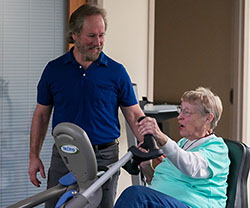At the Heart of the Matter
Cardiac Rehabilitation Helps Keene Valley Resident on Road to Recovery
.jpg)
Beverly O’Connor had a problem. She was missing morning walks with her childhood friend. The issue was with her heart.
“I could never catch my breath and it got to the point where I couldn’t walk for more than a few minutes at a time without stopping,” said O’Connor, a long-time resident of Keene Valley, New York. “When I first arrived at cardiac rehab, I was really scared that I’d never feel well again.”
O’Connor’s journey to cardiac rehabilitation began with a visit to Seema Lodha, MD, a cardiologist at UVM Health Network – Elizabethtown Community Hospital. After running tests of O’Connor’s heart, Dr. Lodha recognized her symptoms were caused by a partially blocked artery that was making it more difficult for her heart to receive the oxygen-rich blood it needed. To address the problem, O’Connor had a stent put in – a tiny mesh tube placed within the affected artery that works to improve blood flow and help restore heart function.
“The stent procedure is just the starting point for returning to better health,” says Dr. Lodha. “Living with a blocked artery places tremendous strain on your heart and cardiovascular system, so it takes time and effort to get back to your best.”
A personalized treatment plan for your heart
Like many patients recovering from a heart procedure or diagnosed with heart disease, O’Connor was referred to the cardiac rehabilitation program at Elizabethtown Community Hospital. Over the course of a few months, she worked with clinical exercise physiologists like Dylan Daniels, CEP, to gradually return to physical activity and learn about what she could do to keep her heart and body healthy.
“Like many of the people that come to us, Bev was really anxious about her health in the beginning,” said Daniels, who typically works with about a dozen people like O’Connor each week. “But she came in with an open mind and desire to learn. She gave the program everything she had from the moment she walked through the door.”
Three days per week, O’Connor spent time with Daniels and his colleagues to better understand her risk factors and tailor a personalized plan for her recovery. A key facet of this plan was to get her moving again and restore her confidence in her body.
“We started slow – whether it was on the treadmill, stationary bike or some other exercise machine – and gradually I felt stronger and more comfortable,” O’Connor says. “And Dylan and the team were always right there by my side encouraging me.”
Changing daily habits
For O’Connor, keeping an open mind was critical because much of cardiac rehab is about undoing old habits and learning new ones to make your lifestyle more heart healthy. O’Connor particularly enjoyed the educational portion of the program, which offered her a chance to better understand her individual risk factors and the daily choices she could make to strengthen her heart. For most people, this means making changes to your diet – like eating less salt and fewer processed foods – getting more exercise, being mindful of stress and cutting back on damaging habits like smoking or drinking alcohol or eliminating them altogether.
“It not easy changing your habits, especially when you’ve been used to living a certain way for most of your life,” O’Connor says. “But the rehab team is so good with the educational part of their program – it makes these choices a no brainer. It made me feel more confident knowing I could do something every day to keep myself healthy.”
The payoff of cardiac rehab is well worth it. Research has shown that completing a cardiac rehabilitation program can drastically reduce a person’s risk of having a second cardiac event like a heart attack, while also improving the quality and length of their life.
“When I finished cardiac rehab, I felt better than I had in a long, long time,” says O’Connor, who recently returned to Daniels for pulmonary rehab after falling ill with an intense bout of COVID. “I’m not yet where I want to be, but I know I’m in great hands here.”
